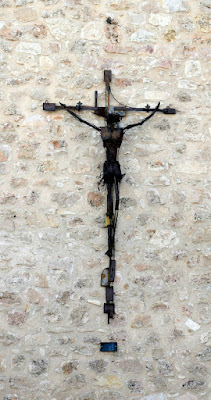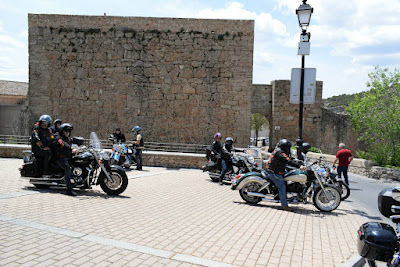Cuenca is really two cities. The lower town is the modern half; the old city is perched high up with precipices on two sides. It has Roman roots and was occupied by the Moors, but until the reconquest by the Christians in 1177, its history is vague. The castle dominates the highest part, and the city developed downwards from there into the layout we see today. The photo underneath was taken from the castle and shows the city’s dramatic position on the cliff edge.
We parked by the castle as it was free. Free, that is, apart
from a scruffy man who claimed to be the attendant. Worth a couple of euros to
make sure your tyres weren’t let down. So down we go through the town gate into
old town.
Lots of medieval alleyways like this, generously adorned
with religious images as befits a Catholic country.
We were following the path down, just alongside the cliff
edge. The houses were very tall in some places, 5 or 6 storeys high. The flimsy
wooden supports upholding this house are set in modern concrete, but how safe
would you feel in past times?
We arrived at the footbridge that spans the gorge. The
building on the opposite side was a Dominican convent, dating from the 16th
century. It is now a Parador, one of a chain of hotels run by the Spanish
government in old and historic premises. What a great way to preserve fine
buildings that would otherwise go to rack and ruin.
We walked across the bridge and on the way back took in the
fine view of some of Cuenca’s famous “hanging houses” (casas colgadas). The
balconies look the most at risk. The nearer balconies belong to a restaurant,
so you could experience a “death by chocolate” dessert in more ways than one!
We head for a lunch of tapas in the central square, sitting
under one of the umbrella sunshades. The air temperature is cooler up here but
the direct sun is powerfully intense.
Our last bit of sightseeing for the day is the cathedral,
which is entered through the central square.
It was started in 1183, soon after the reconquest from the Moors, and was the first Gothic cathedral in Spain. It was constructed on the site of the great mosque, of which there is little remaining evidence. The central courtyard with its fountain is perhaps a connection with those times as Arab planners would always feature water in their important buildings.
Otherwise, the interior is relatively unremarkable compared
to the great cathedrals of Spain. But here is a beautifully worked geometric
ceiling worth showing. In many of the great medieval buildings of Europe,
ceilings and upper parts contain the most intricate work of carvings, statues
and paintings, which are difficult to view because of their high location.
Maybe you got the best view after an over- generous helping of communion wine.
Now plod back up the hill to the castle car park. On the way,
we noticed on a church wall, an example of these strange elongated figures that
we have seen in many locations in Spain, religious and otherwise.
Nearly back at the car park we found a large gathering of
bikers who clearly see the twisting roads in the vicinity as an interesting
challenge ride and meet up here either during or afterwards. There was also a
gay wedding celebration centred on the cafes near the castle, but we thought it
too intrusive to take photos, so you’ll have to make do with the bikers.
Before getting back into the car (tyres all fully inflated!), we looked up the gorge away from the direction of the city, into the wild back countryside. It’s picturesque and inviting on a lovely spring day but in wintertime must have been a bitter, hash environment for the inhabitants in past times.
So that’s Cuenca, most interesting, and highly recommended
for a visit.













No comments:
Post a Comment